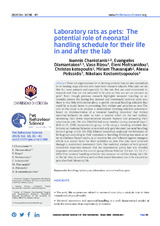Mostrar el registro sencillo del ítem
Laboratory rats as pets: The potential role of neonatal handling schedule for their life in and after the lab
| dc.contributor.author | Chaniotanis, Ioannis | |
| dc.contributor.author | Diamantakosc, Evangelos | |
| dc.contributor.author | Rizou, Vaso | |
| dc.contributor.author | Moltsanidou, Eleni | |
| dc.contributor.author | Kotopoulis, Christos | |
| dc.contributor.author | Thavarajah, Miriam | |
| dc.contributor.author | Polissidis, Alexia | |
| dc.contributor.author | Kostomitsopoulos, Nikolaos | |
| dc.date.accessioned | 2020-12-14T10:45:22Z | |
| dc.date.available | 2020-12-14T10:45:22Z | |
| dc.date.issued | 2020 | |
| dc.identifier.issn | 2445-2874 | |
| dc.identifier.uri | http://hdl.handle.net/10396/20910 | |
| dc.description.abstract | There are organizations for re-homing animals that are also specialized in re-homing dogs and cats who have been research subjects. Why can’t we do this for more animals and especially for the rats that are used extensively in research and they are not intended to be pets as they are not as common as pets? Even though previous research highlights neonatal handling as an essential process for rearing less stressed and emotionally sensitive adult rats, there is very little information about a specific neonatal handling schedule that could be a crucial factor in promoting their welfare and adoption as pets. The aim of this study is to propose a standardized handling schedule assessment based on implementation of a neonatal handling procedure that mimics maternal behavior, in order to have a positive effect on the rats’ welfare, decreasing their stress responsiveness towards humans and promoting their adoption as pets. DA rats (DA/OlaHsd) were handled during postnatal days 1 (D1) to 21 (D21) (experimental group, n=15) using a handling schedule that imitates rat maternal behavior or received only gold standard neonatal handling (control group, n=14). On D22, blinded researchers evaluated the behaviour of both groups according to their responses to handling. Blinding was used, as to try to eliminate biased results, as to examine the rats' behavior against strangers which is a crucial factor for their suitability as pets. The data were collected through a customized assessment form. The statistical analysis of both groups’ cumulative responses showed that the experimental group had less stressful responses compared to the control group (Mann-Whitney (U) test: U= 13; P < 0.01). This neonatal handling schedule may improve rat welfare during their life in the lab. Also, it could be a method that assists laboratory rats to be adopted as pets after their laboratory life. | es_ES |
| dc.format.mimetype | application/pdf | es_ES |
| dc.language.iso | eng | es_ES |
| dc.publisher | Universidad de Córdoba, Departamento de Medicina y Cirugía Animal | es_ES |
| dc.rights | https://creativecommons.org/licenses/by-nc-sa/4.0/ | es_ES |
| dc.source | Pet Behaviour Science 10, 36-45 (2020) | es_ES |
| dc.subject | Handling techniques | es_ES |
| dc.subject | Laboratory animal welfare | es_ES |
| dc.subject | Pets | es_ES |
| dc.title | Laboratory rats as pets: The potential role of neonatal handling schedule for their life in and after the lab | es_ES |
| dc.type | info:eu-repo/semantics/article | es_ES |
| dc.relation.publisherversion | http://www.uco.es/ucopress/ojs/index.php/pet/index | es_ES |
| dc.rights.accessRights | info:eu-repo/semantics/openAccess | es_ES |

